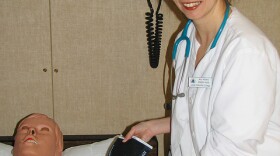Three seniors in the nursing program at the College at Brockport follow Professor Jennifer Chesebro through a long nondescript room with eight occupied hospital beds along the walls.
Chesebro addresses each patient by name, and handles them with the tender touch that she’s developed in 21 years of nursing.
Each patient has their own unique ailments for the students to practice treating, but they stare up with hard fixed plastic eyes. The patients in this room don’t respond to their caregivers—they’re mannequins.
Here, and in another demonstration lab across the hall, students practice drawing blood, inserting I.V.s, and moving patients.
“One of the things that we do the very first few weeks of the program is to talk about back safety because it is one of the number one injuries that happen to nurses and to all healthcare personnel,” said Chesebro.
According to OSHA in 2011, hospitals in the U.S. reported 16,680 cases of workers with musculoskeletal injuries—injuries to the bones, muscles, or ligaments — forcing them to miss work. Most of those were nurses or nursing assistants.
These stats are no surprise to Chesebro’s students.

Jonathan D’Addesio came to nursing school after working in Emergency Medical Services. He understands the importance of following safe lifting practices in his budding career.
“We want to get the patient safely from point A to point B. I've seen the results of when you don't. I don't want to be 35, 40 and having back surgery,” D’Addesio remarked.
Nursing Unions contend that some of these injuries also come from overwork. Long hours on the job can lead to mistakes.
Chesebro says the health care industry is a delicate balancing act—one that weighs patient and employee needs, against costs.
“As much as we try to make sure that we're focused on the taking care of the patients health care when it comes down to it is a business. And you can't run a business profitability if you're spending a lot of money on staffing when you're getting so little money back from insurance companies.”
Unions are pushing state and federal legislation to require staffing ratios that meet patient needs but don’t overextend health care professionals.
Hospital administrators at both Strong and Rochester General say they’ve been aware of the problem for years. Both have “Safe Patient Handling Task Forces” that make sure every nurse is trained in proper lifting techniques. Additionally, hospitals use equipment that will bear a patient's weight if it's more than one or two nurses can handle.
Regardless of a patient's size, the nurse's fitness and strength come into play, as well. Strong Memorial's Chief Nursing Officer Patricia Witzel explains the idea behind a pilot program designed to help nurses create an exercise and physical therapy regime to strengthen nurses and avoid injuries.
“What are those exercises that will help nurses and prevent back injuries? So, we're really trying to be proactive and come up with all sort of new programs to be able to help staff,” Witzel said.
Back at Brockport, Professor Chesebro says hospitals in the greater Rochester area do more to support nurses than she's seen in other parts of the country.
Although Chesebro teaches about these risks every semester, she hasn't lost enthusiasm for the job.
“I'm completely biased, but it's the best profession in the whole world. There's not another job that you can go to and every single day you are doing something to change somebody's life.”
NPR is running a series on workplace injuries among nurses, and that content can be found here.





